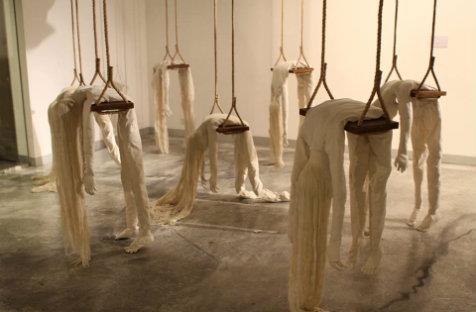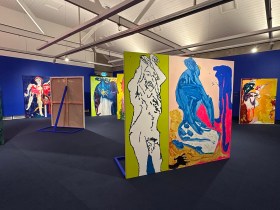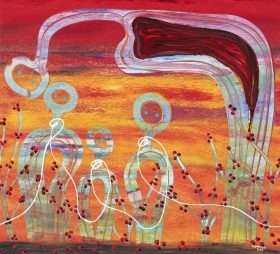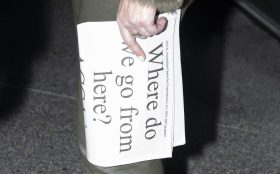Tucked away in Melbourne’s central business district is one of the city’s best-kept secrets – Melbourne Intercultural Fine Art (MiFA) Asian Pacific Contemporary Art gallery. A new platform for contemporary art from the Asia Pacific, MiFA aims to bridge the gap between Australia and its neighbouring countries in the Asia Pacific, thereby facilitating new opportunities for collaboration, discussion and relationships through art. With two years of research and planning behind it, MiFA’s latest exhibition, Crossing Contemporary Cultures is testament to the gallery’s efforts to nurture the burgeoning relationship between Australia and Indonesia.
Cross Contemporary Cultures brings to Australia 11 highly acclaimed Indonesian artists working across all forms of media, including Entang Wiharso (whose work was featured at the 55th Venice Biennale this year), Heri Dono, Krisna Murti, and Ichwan Noor. The exhibition also presents exciting work from Tintin Wulia (who participated in the 7th Asia Pacific Triennial earlier this year in Brisbane), Farhan Siki, Maria Indria Sari, Angki Purbandono, Gusmen Heriadi, Prilla Tania and I Gusti Ngurah Udiantara Tantin. Together, these artists draw on Indonesia’s rich culture, heritage and political history, fusing that with contemporaneity founded in art practice belonging to a globalized world culture, as a means of voicing their deeply personal experiences of modern day Indonesia.
Through a classic arcade claw game, Tintin Wulia invites us to win a new citizenship based on skill and chance. Lure resonates in Tintin’s exploration of migration and identity. The work echoes the artist’s personal experience of searching for her own place of belonging and issues encountered during her travels due to the often rigid and bureaucratic control of geographical borders.
For Maria Indria Sari, the search for understanding lies closer to home. Skilfully crafted and hauntingly beautiful, Postpartum Syndrome #1 – Vacillate, expresses her inner emotional turmoil and sheer physical exhaustion as a mother to a young child. Maria reflects on her own childhood memories of her relationship with her mother, gaining a new understanding in her journey into motherhood.
In the tactile world of sculpture one cannot look past the work of Ichwan Noor, whose Beetle Sphere featured at the inaugural Art Basel Hong Kong earlier this year. Regarded as one of Indonesia’s most renowned contemporary sculptors, his sound technical abilities have earned him a well-respected reputation among his peers. As demonstrated in Memorabilia, his sculptures are both an exploration of engineering concepts as well as a social commentary of the world he lives in.
By contrast of medium, Gusmen Heriadi uses the tradition of painting to explore the inner debates generated by living in a modern society conflicted by the imposing issues of trans-national cultures and local traditions. His paintings, such as the mammoth-scaled News, a diptych, bear a distinctively grim and eerily static atmosphere charged with metaphors of Western cultural influences.
At the forefront of new media art in Indonesia, Krisna Murti is indisputably a pioneer and master of his craft. Krisna Murti’s exemplary video installation, Video Poem, takes us on a mediative journey to discover what the artist considers a poetic experience, private and uniquely individual. As our inner world encounters the world outside, we are given a reprieve from the exhaustive symptoms of living in a rapidly modernising world.
On the other end of the scale from the calm meditation found in Video Poem, a loud splash of colour brings to our attention the work of Farhan Siki. Dubbed as ‘Asia’s Banksy’ by Vogue Italia, Farhan Siki draws heavily on elements of advertising and aspects of street art culture. Body and shop #1 and Body and shop #2 both illustrate the urban experience and the ever-increasing consumerist culture we encounter in our day-to-day lives. The recognition of labels at once brings a feeling of relief and sense of pleasure, yet the fragmentation of the human figure reminds us of the pain of being bombarded in an overcrowded urban society.
The many works exhibited in Crossing Contemporary Cultures illuminate the enormous talent present in contemporary Indonesian art practice. With its eclectic mix of paintings, videos, installation and sculpture, Crossing Contemporary Cultures marks a critical moment in our art discourse where the geographical borders divorcing us from our closest neighbour no longer presents itself as a boundary. To consciously make the choice to embrace a flourishing contemporary Indonesia, we are thereby granting the art the merit it deserves. In Crossing Contemporary Cultures, MiFA has shown why many Australians who encounter Indonesian art instantaneously become enthusiastic fans.
Rating: 3 ½ stars out of 5
Crossing Contemporary Cultures
Featuring works by Angki Purbandono, Entang Wiharso, Farhan Siki, Gusmen Heriadi, Heri Dono, Ichwan Noor, Krisna Merti, Maria Indria Sari, Prilla Tania, Tantin, and Tintin Wulia
MiFA Asian Pacific Contemporary Art, Melbourne
23 August – 27 September
Image: Maria Indria Sari, Postpartum Syndrome #1 – Vacillate, 2012, fabric and mixed media. Photo: Nadine Maulida.





